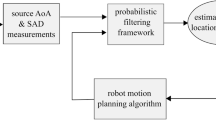Abstract
The tracking of a moving object with a mobile robot has been implemented based on the detected sound from the moving object using a microphone array. The difference between the travel times of the sound source to each of the three microphones mounted to the robot has been used to calculate the distance and orientation of the sound source. The cross-correlations between the received signals have been used to detect the individual sound signal from the object and to calculate the time difference between two signals. This provides reliable and precise time differences among the sound signals arrived at the microphones compared to the conventional method. In order to determine the tracking direction to the sound source, Fuzzy rules have been applied; the results are used for real-time control of the mobile robot. The efficiency of the proposed algorithm has been demonstrated through real-world experiments and compared to the conventional approach.
Similar content being viewed by others
References
Kim, Y.-E., Chung, J.-G.: The Method of Elevation Accuracy in Sound Source Localization. The Institute of Electrical Engineering of Korea (2009)
Silverman, H.F.: Some analysis of microphone arrays for speech data acquisition. IEEE Trans. Acoust. Speech Signal Process. 35(12), 1699–1711 (1987)
Silverman, H.F., Kirtman, S.E.: A two-stage algorithm for determining talker location from linear microphone-array data. Comput. Speech Lang. 6(2), 1129–1152 (1992)
Sturim, D.E., Brandstein, M.S., Silverman, H.F.: Tracking multiple talkers using microphone-array measurements. In: Proceedings of ICASSP97, IEEE (1997)
Svaizer, P., Mattassoni, M., Omologo, M.: Acoustic source localization in a three-dimensional space using crosspower spectrum phase. In: Proceedings of ICASSP97, IEEE (1997)
Nakadai, K., Lourens, T., Okuno, H.G., Kitano, H.: Active audition for humanoid. In: Proceedings of 17th National Conference on Artificial Intelligence (AAAI-2000), pp. 832–839 (2000)
Wang, C., Griebel, S., Brandstein, M.: Real-time automated video and audio capture with multiple cameras and microphones. J. VLSI Signal Process. 29, 81–99 (2001)
Himawan, I., Mccowan, I., Lincoln, M.: Microphone array beamforming approach to blind speech separation. In: Popescu-Belis, A., Renals, S., Bourlard, H. (eds.) MLMI 2007. LNCS 4892, pp. 295–305. Springer, Berlin (2007)
Cox, H., Zeskind, R., Owen, M.: Robust adptive beamforming. IEEE Trans. Acoust. Speech Signal Process. 35, 1365–1376
Sasaki, Y., Kagami, S., Mizoguchi, H.: Multiple sound source mapping for a mobile robot by self-motion triangulation. In: Proceeding of the 2006 IEEE/RSJ International Conference on Intelligent Robots and Systems, pp. 380–385 (2006)
Hwang, S.M., Park, Y.J., Park, Y.-S.: Sound direction estimation using artificial ear. In: Proceedings of ICCAS, pp. 1900–1910 (2007)
Kwon, B.-H., Park, Y.-J., Park, Y.-S.: Spatially mapped GCC function analysis for multiple source and source localization method. IJCAS 16(6), 415–419 (2010)
Carter, G.C., Abraham, P.B.: Estimation of source motion from time delay and time compression measurements. J. Acoust. Soc. Am. 67(3), 830–832 (1980)
Moon, S.-B.: A Study on Ship’s Whistle Sound Tracking System using Microphone Array. Graduate School of Korea Maritime University (2002)
Dibiase, J.H.: A high-accuracy, low-latency technique for talker localization in reverberant environments using microphone arrays. Ph. D. thesis Brown University, Providence, RI (2000)
Klaassen, G., Krose, B.J.A.: Speech-based localization of multiple persons for an interface robot. M. S thesis Intelligent Autonomous Systems, University of Amsterdam (2005)
Fan, J., Luo, Q., Ma, D.: Localization Estimation of Sound Source by Microphones Array. Science Direct, Procedia Engineering, pp. 312–317 (2010)
Jung, Y.-W., Kang, H.-G., Lee, C.-Y., Youn, D.-H.: Adaptive microphone array system with self-delay estimator. J. of KICS 30(1C), 54–60 (2005)
Lim, Y.S., Choi, J.S., Kim, M.-S.: Probabilistic sound source localization. In: Proceedings of ICCAS, pp. 1925–1928 (2007)
Zhao, Y., BeMent, S.L.: Kinematics, dynamics and control of wheeled mobile robots. In: IEEE Conf. Robotics and Automation, pp. 91–96 (1992)
Fahimi, F.: Autonomous Robots. Mechanical Engineering Department, University of Alberta (2008)
Luca, A., Oriolo, D., Samson, G.: Robot Motion Planning and Control: Feedback Control of a Nonholonomic Car-Like Robot. Springer, Berlin (1998)
Lee, S.H., Yi, S.Y., Park, J.O., Lee, C.W.: Reference adaptive impedance control and its application to obstacle avoidance trajectory planning. In: Proc. IEEE/RSJ Int. Workshop on Intel. Robotics and Systems, vol. 2, pp. 1158–1162 (1997)
Kamada, H., Naoi, S., Goto, T.: A Compact Navigation System using Image Processing and Fuzzy Control. IEEE Southeastccn, New Orleans (1990)
Wu, C.-J., Lee, T.-L.: A fuzzy mechanism for action selection of soccer robots. J. Intell. Robot. Syst. 39, 57–70 (2004)
Cheng, C.-T., Lin, J.-Y., Chau, K.: Long-term prediction of discharges in manwan hydropower using adaptive-network-based fuzzy inference systems models. In: Popescu-Belis, A., Renals, S., Bourlard, H. (eds.) ICNC 2005. LNCS 3612, pp. 1152–1161. Springer, Berlin (2005)
Soyupak, S., Chen, D.-G.: Fuzzy logic model to estimate seasonal pseudo steady state chlorophy11-a concentrations in reservoirs. Environ. Model. Assess. 9, 51–59 (2004)
Yang, X., Moallem, M., Patel, R.V.: A fuzzy logic-based reactive navigation algorithm for mobile robots. In: IEEE Conference on Cotrol Applications, Toronto, Canada, 28–31 August (2005)
Jang, W.-S., Lee, J.-M.: A precise localization method for a high speed mobile robot using iGS and dual compass. J. Inst. Control Robot. Syst. 16(12), 1182–1188 (2010)
Vaitulevich, S.F., Shestopalova, L.B.: Interhemisphere asymmetry of auditory evoked potentials in humans and mismatch negativity during sound source localization. Neurosci. Behav. Physiol. 40(7), 629–638 (2010)
Argyros, A., Georgiadis, P., Trahanias, P., Tsakiris, D.: Semi-autonomous navigation of a robotic wheelchair. J. Intell. Robot. Syst. 34, 315–329 (2012)
Jung, K.-O., Oh, S.-K., Kim, D.-H.: Design of S-shaped path and velocity profile of moving Stage using three point locations. J. of KSME 35(1), 145–152 (2011)
Author information
Authors and Affiliations
Corresponding author
Rights and permissions
About this article
Cite this article
Han, J., Han, S. & Lee, J. The Tracking of a Moving Object by a Mobile Robot Following the Object’s Sound. J Intell Robot Syst 71, 31–42 (2013). https://doi.org/10.1007/s10846-012-9769-3
Received:
Accepted:
Published:
Issue Date:
DOI: https://doi.org/10.1007/s10846-012-9769-3



